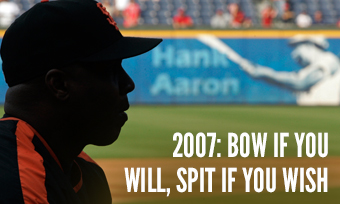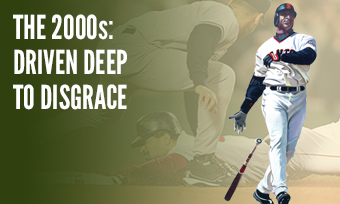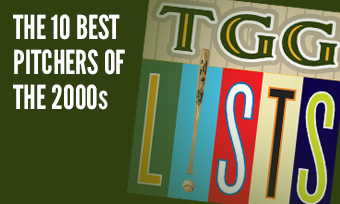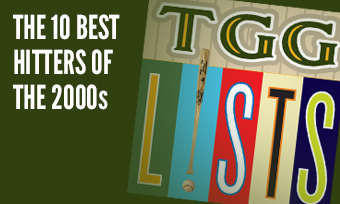The Yearly Reader
Leaders and Honors, 2007
Our list of baseball’s top 10 hitters and pitchers in both the American League and National League for the 2007 baseball season, as well as the awards and honors given to the game’s top achievers of the year.
The National League’s Top 10 Hitters, 2007
Bold type in brick red indicates league leader.
1. Matt Holliday, Colorado
Key Numbers: .340 average, 120 runs, 216 hits, 50 doubles, 6 triples, 36 home runs, 137 RBIs, 10 hit-by-pitches, 11 stolen bases, 23 grounded into double plays.
Thanks to a .372 average at Coors Field, Holliday became the fourth batting champion in Rockies history; five more would follow over the next 10 years.
2. David Wright, New York
Key Numbers: .325 average, 113 runs, 196 hits, 42 doubles, 30 home runs, 107 RBIs, 94 walks, 34 stolen bases.
The All-Star third baseman became the third Met, after Howard Johnson and Darryl Strawberry, to reach 30-30 territory.
3. Prince Fielder, Milwaukee
Key Numbers: .288 average, 109 runs, 35 doubles, 50 home runs, 119 RBIs, 90 walks, 21 intentional walks, 14 hit-by-pitches.
Fielder emulated his estranged father Cecil of 18 years earlier and became part of the first father-son duo to each belt 50 homers in a season.
4. Chipper Jones, Atlanta
Key Numbers: 134 games, .337 average, 108 runs, 173 hits, 42 doubles, 29 home runs, 102 RBIs, 82 walks, 21 grounded into double plays.
NL East teams were surely sending notes to the Braves to trade the venerable All-Star so they didn’t have to face him all the time; Jones hit .350 with 19 of his 29 homers in just 59 games against divisional competition.
5. Hanley Ramirez, Florida
Key Numbers: .332 average, 125 runs, 212 hits, 48 doubles, 6 triples, 29 home runs, 81 RBIs, 51 stolen bases.
A graduate of the Marlins’ voluminous (and dirt-cheap) rookie class of 2006, Ramirez flourished in the early portion of a career in which he excelled in both power and speed.
6. Ryan Braun, Milwaukee
Key Numbers: 113 games, .324 average, 91 runs, 26 doubles, 6 triples, 34 home runs, 97 RBIs, 15 stolen bases, .634 slugging percentage.
Outstanding numbers not just for any rookie, but one who didn’t even make his MLB debut until the Memorial Day weekend.
7. Chase Utley, Philadelphia
Key Numbers: 132 games, .330 average, 104 runs, 176 hits, 48 doubles, 5 triples, 22 home runs, 103 RBIs, 25 hit-by-pitches.
The All-Star second baseman with that consistently dry, forlorn stare began a stretch of three seasons easily leading the NL getting hit by pitches; the 17th HBP of 2007 cost him a month of play when it broke his ring finger.
8. Jimmy Rollins, Philadelphia
Key Numbers: 162 games, .296 average, 716 at-bats, 139 runs, 212 hits, 38 doubles, 20 triples, 20 home runs, 94 RBIs, 41 stolen bases.
Rollins won the NL MVP—barely out-tabulating runner-up Matt Holliday—perhaps as much for his soothsaying as his productivity; he promised, and helped delivered, a divisional title for the Phillies.
9. Ryan Howard, Philadelphia
Key Numbers: .268 average, 94 runs, 26 doubles, 47 home runs, 136 RBIs, 107 walks, 199 strikeouts, 35 intentional walks.
The Phillies’ über-slugger joined the growing movement of throwing the contact-hitting manual out the door, constantly swinging for the fences even if it meant a ton of strikeouts along the way.
10. Miguel Cabrera, Florida
Key Numbers: .320 average, 91 runs, 188 hits, 38 doubles, 34 home runs, 119 RBIs, 23 intentional walks.
Another year of automatic excellence from the 24-year-old Venezuelan; even arbitration wages were too much for the penny-pinching Marlins, who didn’t want to pay Cabrera not-quite-top dollar a year later and traded him (along with pitcher Dontrelle Willis) to Detroit for six players—none of whom panned out for Florida.
The American League’s Top 10 Hitters, 2007
1. Alex Rodriguez, New York
Key Numbers: .314 average, 143 runs, 183 hits, 31 doubles, 54 home runs, 156 RBIs, 95 walks, 21 hit-by-pitches, 24 stolen bases, .645 slugging percentage.
A-Rod dominated in Yankee pinstripes like never before, with numerous walk-off home runs—all before fizzling once again in the playoffs.
2. Magglio Ordonez, Detroit
Key Numbers: .363 average, 117 runs, 216 hits, 54 doubles, 28 home runs, 139 RBIs, 20 grounded into double plays.
Even .363 was considered a spike for Ordonez, who consistently hit over .300; it was the highest average posted by a Tiger since Charlie Gehringer in 1937.
3. David Ortiz, Boston
Key Numbers: .332 average, 116 runs, 182 hits, 52 doubles, 35 home runs, 117 RBIs, 111 walks, .445 on-base percentage.
Although Ortiz saw reduced power numbers—after hitting 54, there was almost nowhere to go but down—he still made up for it by setting career highs in batting average, on-base percentage and doubles.
4. Carlos Pena, Tampa Bay
Key Numbers: .282 average, 99 runs, 29 doubles, 46 home runs, 121 RBIs, 103 walks, 10 hit-by-pitches.
Pena, whose career looked dead and buried after years of struggling at the plate, engaged in a startling rejuvenation in Tampa Bay.
5. Curtis Granderson, Detroit
Key Numbers: .302 average, 122 runs, 185 hits, 38 doubles, 23 triples, 23 home runs, 74 RBIs, 26 stolen bases, 1 caught stealing.
Along with Jimmy Rollins, Granderson became one of two players in 2007—and just two of four in major league history—to collect at least 20 doubles, 20 triples, 20 home runs and 20 steals in a season.
6. Vladimir Guerrero, Los Angeles of Anaheim
Key Numbers: .324 average, 89 runs, 186 hits, 45 doubles, 27 home runs, 125 RBIs, 28 intentional walks.
Though it’s commonly thought that his knees were shot from years of abuse performing on Montreal’s hard fake turf, Guerrero still played the majority of the Angels’ season in right field—and hit .345 when doing so, as opposed to .270 as a DH.
7. Jim Thome, Chicago
Key Numbers: 130 games, .275 average, 35 home runs, 96 RBIs, 95 walks.
If not for a slow start exacerbated by rib pains that knocked him out of action for three weeks, Thome might have had yet another shot at 40 home runs.
8. Grady Sizemore, Cleveland
Key Numbers: 162 games, .277 average, 118 runs, 174 hits, 34 doubles, 5 triples, 24 home runs, 78 RBIs, 101 walks, 17 hit-by-pitches, 33 stolen bases.
It seemed there was nothing the tireless young center fielder couldn’t do—and perhaps that overextension of talent would lead to a premature career downfall in the coming years.
9. Jorge Posada, New York
Key Numbers: .338 average, 91 runs, 171 hits, 42 doubles, 20 home runs, 90 RBIs.
The veteran Yankee catcher, who batted .267 in 16 other seasons wearing pinstripes, enjoyed an unusually effective year at the plate with his only .300+ average.
10. Ichiro Suzuki, Seattle
Key Numbers: .351 average, 678 at-bats, 111 runs, 238 hits, 22 doubles, 7 triples, 6 home runs, 68 RBIs, 37 stolen bases.
Ichiro became the first major leaguer to collect 200 hits in each of his first seven years.
The National League’s Top 10 Pitchers, 2007
1. Jake Peavy, San Diego
Key Numbers: 2.54 ERA, 19 wins, 6 losses, .760 win percentage, 34 starts, 223.1 innings, 240 strikeouts, 21 stolen bases allowed.
Many believed the spacious conditions at San Diego’s Petco Park subsidized Peavy’s bid for the NL Cy Young Award—but his numbers on the road were actually better.
2. Brandon Webb, Arizona
Key Numbers: 3.01 ERA, 18 wins, 10 losses, 34 starts, 4 complete games, 3 shutouts, 236.1 innings, 26 stolen bases allowed, 20 grounded into double plays.
Webb was the primary reason the Diamondbacks were able to win so many low-scoring games. All three of his shutouts came in succession—no other NL pitcher threw more than one in 2007—and took place during a consecutive scoreless inning streak of 42.2, longest in Diamondbacks history.
3. Tim Hudson, Atlanta
Key Numbers: 3.33 ERA, 16 wins, 10 losses, 34 starts, 224.1 innings, 53 walks, 26 grounded into double plays.
After a rough (4.86 ERA) first year with the Braves, Hudson returned to being more like his old Oakland self.
4. Brad Penny, Los Angeles
Key Numbers: 3.03 ERA, 16 wins, 4 losses, .800 win percentage, 33 starts, 208 innings, 29 grounded into double plays.
Possessing the NL’s fastest heater (on average), the former Marlin enjoyed his best performance of 14 seasons in his fourth year at Los Angeles.
5. Takashi Saito, Los Angeles
Key Numbers: 1.40 ERA, 2 wins, 1 loss, 39 saves, 4 blown saves, 63 appearances, 64.1 innings.
Not getting any younger at age 37, Saito improved on his MLB debut the year before and easily led all closers in ERA.
6. Jason Isringhausen, St. Louis
Key Numbers: 2.48 ERA, 4 wins, 0 losses, 32 saves, 2 blown saves, 63 appearances, 65.1 innings.
The last big dance on the mound for the veteran closer who surpassed age 35; he would succumb to ineffectiveness and injury a year later and never return to form.
7. John Smoltz, Atlanta
Key Numbers: 3.11 ERA, 14 wins, 8 losses, 32 starts, 205.2 innings, 47 walks.
Twenty years after his debut with the Braves, the 40-year-old Smoltz pitched as well as ever. The eternal youth potion would finally run dry a year later.
8. Roy Oswalt, Houston
Key Numbers: 3.18 ERA, 14 wins, 7 losses, 32 starts, 212 innings.
As the Astros were grinding down toward absentia, Oswalt did his usual best to keep the team relevant.
9. Trevor Hoffman, San Diego
Key Numbers: 2.98 ERA, 4 wins, 5 losses, 42 saves, 7 blown saves, 61 appearances, 57.1 innings.
On the edge of turning 40, Hoffman still brought A-list effort to the ninth, saving 40 games for the ninth (and last) time while surpassing 500 for his career.
10. Derek Lowe, Los Angeles
Key Numbers: 3.88 ERA, 12 wins, 14 losses, 32 starts, 199.1 innings, 21 grounded into double plays.
A sloppy stretch run (5.56 ERA after July 14) ruined what had been a great season to date; otherwise, Lowe would rank much higher on this list.
The American League’s Top 10 Pitchers, 2007
1. Fausto Carmona, Cleveland
Key Numbers: 3.06 ERA, 19 wins, 8 losses, .704 win percentage, 32 starts, 215 innings, 11 wild pitches, 32 grounded into double plays.
After a torturous, 1-10 rookie campaign, Carmona—later rebranded as Roberto Hernandez—did a complete about-face and emerged as a worthy equal to teammate/AL Cy Young Award winner C.C. Sabathia.
2. C.C. Sabathia, Cleveland
Key Numbers: 3.21 ERA, 19 wins, 7 losses, .731 win percentage, 34 starts, 241 innings, 37 walks, 23 grounded into double plays.
Sabathia became only the second Cy Young Award winner to wear a Cleveland jersey. Gaylord Perry, in 1973, was the other.
3. J.J. Putz, Seattle
Key Numbers: 1.38 ERA, 6 wins, 1 loss, 40 saves, 2 blown saves, 68 appearances, 71.2 innings, 13 walks, 7 grounded into double plays.
The Mariners’ closer continued to be a big-time major league secret except for those in and around Seattle.
4. John Lackey, Los Angeles of Anaheim
Key Numbers: 3.01 ERA, 19 wins, 9 losses, .679 win percentage, 33 starts, 2 shutouts, 224 innings, 12 wild pitches, 23 grounded into double plays.
Sign of the times: For the third time in five years, Lackey led (or co-led) the AL in shutouts. In each of those years, he threw two. In 2007, both of his blankings came against Seattle.
5. Josh Beckett, Boston
Key Numbers: 3.27 ERA, 20 wins, 7 losses, .741 win percentage, 30 starts, 200.2 innings, 40 walks.
Mortgaging the future for now never paid off more for the Red Sox than after trading, a couple of years earlier, then-unknowns Hanley Ramirez and Anibal Sanchez to the Marlins for Beckett (and Mike Lowell). The hard-throwing righty responded with a career-high total in wins—and a 4-0 postseason mark to boot.
6. Erik Bedard, Baltimore
Key Numbers: 3.16 ERA, 13 wins, 5 losses, .722 win percentage, 28 starts, 182 innings, 221 strikeouts.
Bedard’s second straight session of success included a Baltimore-era record-tying 15 strikeouts on July 2 at Texas.
7. Kelvim Escobar, Los Angeles of Anaheim
Key Numbers: 3.40 ERA, 18 wins, 7 losses, .720 win percentage, 30 starts, 195.2 innings, 28 grounded into double plays.
The cousin of future star Ronald Acuna Jr., Escobar easily set a career high in wins at age 31—and then tore his shoulder the next spring. He would pitch just one more game.
8. Chien-Ming Wang, New York
Key Numbers: 3.70 ERA, 19 wins, 7 losses, .731 win percentage, 30 starts, 199.1 innings, 32 grounded into double plays.
The third-year Yankee began to understand how Mike Mussina felt when it came to the elusive goal of winning 20 games; for the second straight season, he finished one victory shy of the milestone.
9. Roy Halladay, Toronto
Key Numbers: 3.71 ERA, 16 wins, 7 losses, .696 win percentage, 31 starts, 7 complete games, 225.1 innings, 48 walks, 20 stolen bases allowed, 28 grounded into double plays.
The Toronto ace switched onto workhorse cruise control, pacing the league in complete games for the first of five straight years.
10. Joe Nathan, Minnesota
Key Numbers: 1.88 ERA, 4 wins, 2 losses, 37 saves, 4 blown saves, 68 appearances, 71.2 innings.
Nathan’s sustained brilliance in the ninth prompted the Twins to give him a four-year, $47 million extension starting in 2008.









